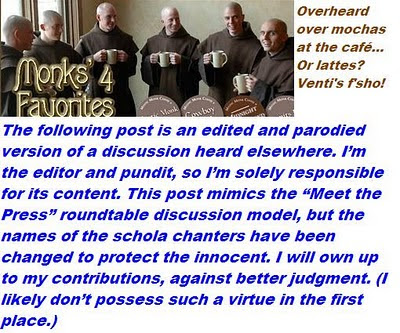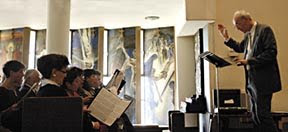A great deal of prognostication of late focuses upon whether we who speak the King’s English are being shepherded towards the narrow sheep-gate over which hangs the sign “ICEL-approved chant settings.”
Personally, I don’t find that scenario at all displeasing. Fact is, it would be at the least a refreshing change from the tyranny of options that both the GIRM and the marketplace inundate us all with weekly. To its merit, issuing some sort of binding legislation to literally universally learn the ICEL chants would be a clarion call that “WE” mean business when it comes down to constituting truly catholic worship; equivocating wimps R us no mo’!
But how can the average parish, say like St. Omnibus in Saskatoon or Stockton, musically prepare themselves for the cognitive combustion of a mandated use of the ICEL chants which would displace, even for only a while, the normative ease of continued reliance upon the status quo, Gather Us In to Sing to the Mountains of Massive Creation?
Well consider the fact that anecdotally, St. Omnibus worship has been besot by a persistent tension and calcification in its physiology, it suffers from occasional tonic spasms by irregular consumption of newly concocted musical “antidotes” to boredom, diffidence and stagnation within the Body. The industry devotes the front piece and pages of its new catalogues to the latest synthesis of glucosamine, St. John’s Wort, Green Tea and caffeine-based compounds as bold new solutions to very natural and long-known maladies.
Well, Dr. Invigaro recommends a protocol for St. Omnibus that is gradual, orderly and as non-invasive as it is non-threatening to a repertoire body that has grown slovenly and unwieldy. It’s called “Prescriptive Solemnity.”
Here’s the regimen (there is no one magic bullet.)
+However it can be managed, start using the Introit Antiphon and verses/Gloria Patri as a prelude, assuming St. Omnibus policy requires an Entrance or “Gathering” hymn. Whether or not this pre-emptive pill is taken up by the congregation along with the music ministry is not to be deliberated as important. The importance lies in preparing the congregation with new cell growth that will eventually result in a new understanding of how the body functions at the beginning of liturgy. The closer the Introit can come to a chanted form, the better. Use any instruments sparingly; the voice and Word must build strong new tendons.
+If and whenever possible, choose an Entrance hymn/song whose textual content has at its source the scriptural attributes of the Introit, or has recognizable ties to the proper Introit. If any group/cantor’s repertoire is so malnourished that such relationships can’t be found, then discern the best of the scriptural inferenced hymns for the day, or if one must, fall back on the publisher’s assigned categorical choices.
+For the opening rite, if St. Omnibus uses an Asperges or Confiteor/Kyrie penitential rite, consider switching to a purely chanted version of either form as soon as possible. This prescriptive also is recommended for the Lamb of God/Agnus Dei litany.
All of these can remain accompanied tastefully, artfully. But their elegant simplicity is best served by chanting, not metered singing. If one is concerned about melodic consistency, just defer that concern to aligning the tonal/modal key centers to the Gloria which follows.
+Regarding the Glory/Gloria: the increase of cellulite in this era seems to not result from serving up portions of the hymn text in different thematic portions, but from the calorie rich, nutrient deficient repetition of a refrain. Consider auditioning leaner, meaner settings that use musical motifs repeatedly for ease of consumption and digestion, but whose text is sung without needless redundancy.
+The Psalm: Dr. Invigaro simply advocates using the psalm or gradual text assigned for the day from the myriad sources available. Strict adherence to the regimen means that paraphrases of the assigned psalm, and even seasonal psalms are best left on the shelf, if palatable versions that aren’t burdened with excessive compositional forms or over-cooked, heavily spiced-up pharmacological soups.
+The Gospel Acclamation: dump all the triumphal gospel or Celtic processionals into the waste bin. Let the body thrive by chanting the beautiful acclamation, “Alleluia.” If mode VI was good enough for your granny, it’s good enough medicine for you. If you’re worried about gender inclusive issues, sing the setting borrowed version from “O filii et filiae.”
+The Creed: Dr. Invigaro defers to the local practitioner the final analysis per this portion of the regimen. He does suggest that recitation actually may be more beneficial than a recto tono declamation. However, he does endorse both the benefits of the de Angelis chant or the use of psalm tones as a mineral enhancement.
+The Offertory: this portion of the protocol demands the patient’s attentiveness and acumen in order for the whole of the process to eventuate with success. The Body of the faithful at St. Omnibus will likely not know that this portion of the liturgy actually is a procession. Some may regard this portion of time as a moment to musically reflect upon the transition of cognition to digestion, and the coughing up of the monetary cud. Others may think that these few moments provide a relief from the disciplined attention demanded by their active listening to various modes of elocution, including those with tones. Dr. Invigaro suggests that, whenever possible, in the absence of the ability to use the proper processional antiphon, even those of Mssrs. Rice, Bartlett or Revs. Kelly, Weber, et al., that an alius cantus aptus that best expresses the homiletics gleaned from the lessons will first do no harm.
+This next prescriptive item is sensitive, so imaging the good doc whispering: the patient should prevail upon the presiding ministers to boldly chant where no presbyter has chanted before at St. Omnibus– the Preface Dialogue and Preface. To nurse the congregation towards acceptance of their own priestly responsibilities, the celebrant must swallow and take down his own Castor Oil and chant these “collects.” Simply put, they’ll then know they are Catholics by their chants, by their chants, yes they’ll know they are Catholics by their chants.
+The Eucharistic Acclamations: the doc strongly emphasizes that the taking up of the “Sanctus” (“Holy” doesn’t quite translate with panache, does it?) is among the most prominent “source and summit” moments of the solemn rites. It calls the question to the Body: are we One, at least in our real time, with angels and saints, or not? Well, yeah. But the combustibility of that notion requires serious temperament with our musical prescriptions. So Dr. Invigaro finds himself in the unique company of both Dr. Hahn and the late Rev. E. Walsh. But if there is a moment of clarity for the most jaded, it is now in the regimen: the people must take up the song humbly and with some measure of shock and awe. So, stepwise motion that disguises the steps, harmonies that are more inferred or imagined by the mind and heart, and a familiarity that eschews banality are all called for in this moment. This is precisely a moment when head-banging meter is to be avoided as a plague. This is a potent moment, calling not for a dalliance with liqueur or aperitif. This is a moment where the terroire, the vine, the tender, the vintner, the server and the guest become one with creation and Creator. So whether a preference by the body is a convenient buzz provided by a Bud or TwoBuckChuck, and to move on, avoid this convenience and lead the Body towards the sublime, the eternal musica sacra. Dr. Invigaro left no notes regarding the “memorial acclamation” or the “Amen,” in which the congregation and celebrant acknowledge consensus of the sacral moment. So, in keeping with the discipline of exercising atrophied muscle mass, use chant as the tonic.
+The Agnus Dei: for opaque reasons, this litany’s text seems to elicit participation in proportion to the sentimentality of the setting of the text. Dr. Invigaro reminds the patient to be mindful that this is not an expression of blatant emotion or a child-like fondness for images of tiny, tender animals, rather it is a moment of profound, against-all-odds final plea for healing and mercy. It cannot be manufactured, troped into faux-ebullience or masqued by sweet herbs. It must taste, at once, sweet and bitter, elemental but refined, ethereally beautiful as it is held down by gravitas. Once the celebrant returns to the ciborium and chalice from “the Peace,” the chant is to be rendered as pristinely it was created.
+Communion: in St. Omnibus’s around the orb it might be customary to extend the Agnus Dei to accompany the reception of the celebrant(s) and the distribution of vessels to EMHC’s (don’t even go there, for now!) This reality can be easily dealt with by the most timely use of the Communio proper by the choir. Yes, there are many hymns and songs whose lyrics recall (with relative success) a Eucharistic ethos. There are others that functionally paraphrase the propers themselves. Both of those options do no harm, and in specific instances, are beneficial to the welfare of the Body. But, if ever there is a moment of prescriptive discipline that a musician can employ without fear of redress, it would be this moment. As long as the Body understands that this portion of the regimen is particularly mandatory for their own welfare, they will appreciate its immediate effect while their full attention is focused upon receiving the host of everlasting life, the salve of redemption. If a communal singing of a hymn is taken up as an honest chaser after each week’s prescribed proper formula, then so much the better. And should sufficient time that does not impede reverent silence before the Communion procession has ended for the choir to augment the beautiful thanksgiving in sound, then choirs, work your art for His and our sake.
+The dismissal is just that: people leave to realize (or not) the “missio” in commission.
Dr. Invigaro has no recommendation for this “moment.” However, he offers a caveat that it is not a moment, like all that came before, for self actualization, aggrandizement or celebratory inebriation.
Below is your correspondent’s unique but fairly representative formulae for “prescriptive solemnity.” You are free to adjudicate it as a real tonic or a recipe of snake oil. But, we believe we’ll be better prepared to receive the change coming next winter because we have laid down a discipline plan for years now.
28th Sunday, Ordinary Time ©
Introit/Prelude “If You, O Lord, laid bare out guilt…”/Simple Choral Gradual-R.Rice
Entrance: S(chola) GATHER US TOGETHER
E(nsemble) LET US GO TO THE ALTAR
Opening Rites S Kyrie (chant)/Glory to God-(Oecumenica/Proulx-Culbreth)
E Kyrie (Sleeth)//Dancing Day Gloria (P.Ford)
Responsorial Respond & Acclaim
Gospel Accl. S “Alleluia” chant Mode VI
E “Alleluia” Sleeth
Offertory S LEAD ME, GUIDE ME
E JESUS, YOU ARE THE HEALING
Eucharistic Accl. S Oecumenica/Agnus Dei (chanted)
E Sleeth Acclamations
Communio “The rich suffer want….”/SCG-Richard Rice
Commnion Hymn SE YOU ARE MINE
Anthem/Song S ADORAMUS TE CHRISTE (Palestrina)
E EYE HAS NOT SEEN
Dismissal S LORD, YOU GIVE THE GREAT COMMISSION (Abbots leigh)
E I HEARD THE VOICE OF JESUS (Kingsfold)







